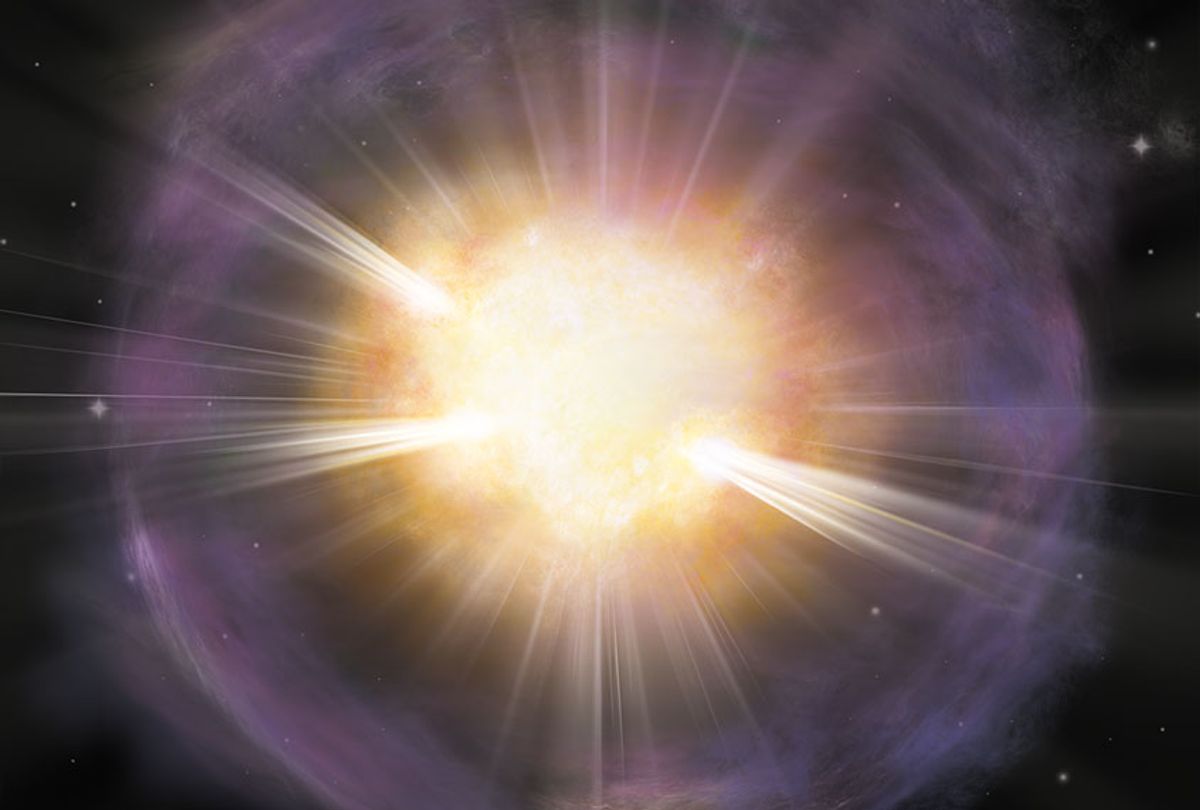Earth just got zapped.
On Sunday a gamma-ray burst (GRB), the most powerful class of explosions in the universe, caused a wave of gamma rays and X-rays to sweep over Earth. It was also possibly the brightest explosion of its nature ever recorded. The event was reported in the Astronomers Telegram.
In a breathless press release, NASA emphasized that their detectors all over the planet picked up on this, including NASA's Fermi Gamma-ray Space Telescope, the Neil Gehrels Swift Observatory, and the Wind spacecraft.
Gamma-ray bursts are some of the most powerful releases of energy in the universe. Their causes may vary slightly, but typically relate to black holes. Some may be caused when merging neutron stars create a black hole, or when a neutron star and a black hole merge. Because they are so energetic, even a gamma-ray burst that originates on the other side of the universe will often be detectable by astronomers on Earth.
Gamma rays are the most energetic photons in the electromagnetic spectrum, far more powerful than x-rays, which can cause cancer if one is exposed to them at high levels. Outer space is full of gamma rays, though few make it all the way to Earth's surface, as the atmosphere absorbs the vast majority before they can ever make it down to hurt us.
However, a sufficiently large gamma-ray burst could theoretically strip the planet of its atmosphere and cause a mass extinction event. Indeed, it is widely believes that a gamma-ray burst caused the Ordovician extinction roughly 443 million years ago. Fortunately for contemporary humans, no GRBs in recent memory have been close enough to Earth to have that effect. Approximately 30 percent of them are short bursts that span only a couple seconds, while the bulk of the rest usually only last for a few minutes.
GRBs were first discovered by scientists accidentally in the 1960s, and even then they realized that these bursts generate as as much energy as our sun will during its entire 10 billion year lifetime. On this recent occasion, the explosive event — now officially dubbed GRB 221009A — traveled roughly 1.9 billion light years to reach Earth, originating as it did all the way from the direction of the constellation Sagitta. Coincidentally, it happened to arrive at the same moment when gamma-ray astronomers were gathered in the South African city of Johannesburg for the 10th Fermi Symposium. Needless to say, they were impressed by the symbolically rich timing.
Judy Racusin, a Fermi deputy project scientist at NASA's Goddard Space Flight Center in Greenbelt, Md. who is attending the conference, said in a statement that "it's safe to say this meeting really kicked off with a bang — everyone's talking about this."
Want more health and science stories in your inbox? Subscribe to Salon's weekly newsletter The Vulgar Scientist.
Preliminary analysis indicates that the Fermi's Large Area Telescope (LAT), a space telescope, managed to detect the radiation pulse for approximately 10 hours. Astronomers believe that the pulse originated in a new black hole being created as a massive star collapsed under its own weight. As a result, astronomers believe that the information obtained by measuring this radioactive pulse can provide new insights into how black holes are created and the dynamics involved in a star's collapse, among many other things.
Because it is believed to have released 18 teraelectronvolts of energy, scientists are preparing to dub it as a precedent-setter, given that no previous gamma-ray burst is ever known to have surpassed 10 teraelectronvolts.
"This burst is much closer than typical GRBs, which is exciting because it allows us to detect many details that otherwise would be too faint to see," Roberta Pillera, a Fermi LAT Collaboration member and doctoral student at the Polytechnic University of Bari, Italy in a press statement about the burst. "But it's also among the most energetic and luminous bursts ever seen regardless of distance, making it doubly exciting."
Several media outlets covering the explosion described it in historic terms. Because it is believed to have released 18 teraelectronvolts of energy, scientists are preparing to dub it as a precedent-setter, given that no previous gamma-ray burst is ever known to have surpassed 10 teraelectronvolts. Space.com described it as "the most powerful flash of light ever seen," while Phys.org called it possibly the "most powerful explosion ever recorded." Jillian Rastinejad, a graduate student at Northwestern University who led one of two independent teams that used the Chilean Gemini South telescope to study the event, described it as "the 'BOAT,' or Brightest Of All Time, because when you look at the thousands of bursts gamma-ray telescopes have been detecting since the 1990s, this one stands apart."



Shares